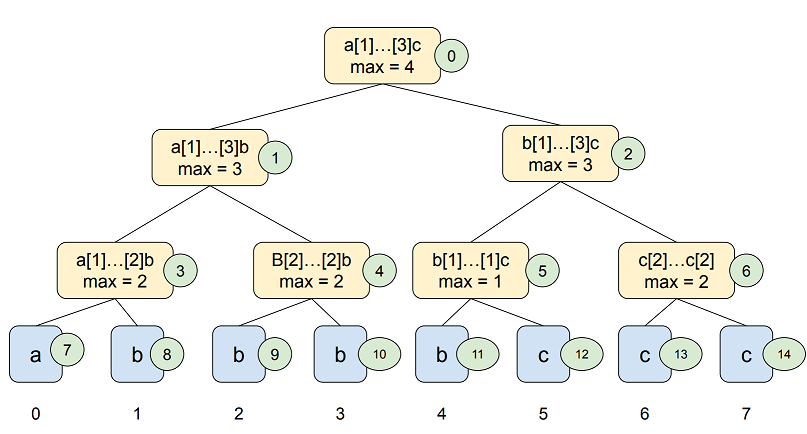Description
You are given a 0-indexed string s. You are also given a 0-indexed string queryCharacters of length k and a 0-indexed array of integer indices queryIndices of length k, both of which are used to describe k queries.
The i<sup>th</sup> query updates the character in s at index queryIndices[i] to the character queryCharacters[i].
Return an array lengths of length k where lengths[i] is the length of the longest substring of s consisting of only one repeating character after the i<sup>th</sup> query is performed.
Example 1:
<strong>Input:</strong> s = "babacc", queryCharacters = "bcb", queryIndices = [1,3,3]
<strong>Output:</strong> [3,3,4]
<strong>Explanation:</strong>
- 1<sup>st</sup> query updates s = "<u>b<strong>b</strong>b</u>acc". The longest substring consisting of one repeating character is "bbb" with length 3.
- 2<sup>nd</sup> query updates s = "bbb<u><strong>c</strong>cc</u>".
The longest substring consisting of one repeating character can be "bbb" or "ccc" with length 3.
- 3<sup>rd</sup> query updates s = "<u>bbb<strong>b</strong></u>cc". The longest substring consisting of one repeating character is "bbbb" with length 4.
Thus, we return [3,3,4].
Example 2:
<strong>Input:</strong> s = "abyzz", queryCharacters = "aa", queryIndices = [2,1]
<strong>Output:</strong> [2,3]
<strong>Explanation:</strong>
- 1<sup>st</sup> query updates s = "ab<strong>a</strong><u>zz</u>". The longest substring consisting of one repeating character is "zz" with length 2.
- 2<sup>nd</sup> query updates s = "<u>a<strong>a</strong>a</u>zz". The longest substring consisting of one repeating character is "aaa" with length 3.
Thus, we return [2,3].
Constraints:
1 <= s.length <= 10<sup>5</sup>sconsists of lowercase English letters.k == queryCharacters.length == queryIndices.length1 <= k <= 10<sup>5</sup>queryCharactersconsists of lowercase English letters.0 <= queryIndices[i] < s.length
Code
abbbbccc 的 segment tree 會長這樣:

Time Complexity: , Space Complexity:
#define left_child 2 * index + 1
#define right_child 2 * index + 2
class sgtree{
public:
vector<int> maxConsecutive, start_from_right, start_from_left;
vector<char> left_end_char, right_end_char;
int n;
sgtree(string &s){
n = s.size();
maxConsecutive = vector<int>(4 * n, 0);
start_from_right = vector<int>(4 * n, -1);
start_from_left = vector<int>(4 * n, -1);
left_end_char = vector<char>(4 * n, '*');
right_end_char = vector<char>(4 * n, '*');
build(0, s, 0, n - 1);
}
int getMax() {
return maxConsecutive[0];
}
void build(int index, string &s, int l, int r){
if(l == r){
left_end_char[index] = right_end_char[index] = s[l];
start_from_right[index] = l, start_from_left[index] = l;
maxConsecutive[index] = 1;
return;
}
int m = (l + r) / 2;
build(left_child, s, l, m);
build(right_child, s, m+1, r);
merge(index, l, m, r);
}
void merge(int index, int l, int m, int r){
int max_ = 0;
left_end_char[index] = left_end_char[left_child];
right_end_char[index] = right_end_char[right_child];
start_from_right[index] = start_from_right[left_child];
start_from_left[index] = start_from_left[right_child];
if(right_end_char[left_child] == left_end_char[right_child]){
if(start_from_right[left_child] == m) start_from_right[index] = start_from_right[right_child];
if(start_from_left[right_child] == m + 1) start_from_left[index] = start_from_left[left_child];
max_ = start_from_right[right_child] - start_from_left[left_child] + 1;
}
maxConsecutive[index] = max(max_, max(maxConsecutive[left_child], maxConsecutive[right_child]));
}
void update(int index,int l, int r, int j, char ch){
if(j < l || j > r) return;
if(j == l && j == r){
left_end_char[index] = right_end_char[index] = ch;
start_from_right[index] = l, start_from_left[index] = l;
maxConsecutive[index] = 1;
return;
}
int m = (l + r) / 2;
update(left_child, l, m, j, ch);
update(right_child, m + 1, r, j, ch);
merge(index, l, m, r);
}
};
class Solution {
public:
vector<int> longestRepeating(string s, string q, vector<int>& in) {
sgtree node(s);
vector<int> res(q.size(),0);
for(int i = 0; i < q.size(); ++i){
node.update(0, 0, s.size()-1, in[i], q[i]);
res[i] = node.getMax();
}
return res;
}
};